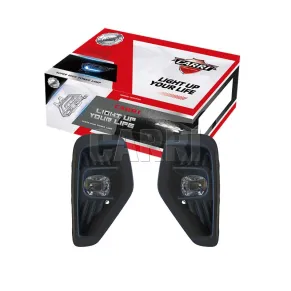Car Fog Lights Explained: Types, Benefits and When To Use
Aug. 07, 2025
Driving in poor visibility conditions, such as fog, heavy rain, or snow, can be extremely dangerous. Limited visibility is a leading cause of road accidents. To help improve safety in these conditions, vehicles are equipped with various safety features, and one such important add-on is fog lights. These specialised lights improve visibility in difficult weather conditions.
However, fog lights are often misused by drivers who use them all the time. While others think they are unnecessary. In this guide, we will understand the purpose of fog lights in car, their benefits, the myths surrounding them, and the best practices for using them correctly.
What Are Fog Lights in Cars?
Fog lights are an auxiliary vehicle lighting system designed to improve visibility in foggy, misty, rainy, or snowy weather conditions. Unlike regular headlights, which can reflect off fog and create glare, fog lights are positioned lower on the vehicle to cast a wide, horizontal beam closer to the road surface.
Key Features of Fog Lights:
Low mounting position: Usually installed lower on the front bumper to reduce glare from fog.
Wide and short beam: The beam is directed downward to light up the road rather than dispersing into the fog.
Typically yellow or white: These colours reduce glare and penetrate fog, rain, and snow more effectively than standard headlights.
Separate from standard headlights: Fog lights have a dedicated switch and are not automatically turned on with headlights.
Available in front and rear: Front fog lights help drivers see better, while rear fog lights make the vehicle more visible to others.

Types of Fog Lights
| Type | Description |
|---|---|
| Front Fog Lights | Mounted on the front bumper, these lights enhance road visibility for the driver. |
| Rear Fog Lights | Located at the back of the vehicle, they help other drivers see your car in low-visibility conditions. |
| LED Fog Lights | Bright and energy-efficient, offering superior performance compared to halogen lights. |
| Halogen Fog Lights | Traditional fog lights that are less bright than LEDs but still provide effective illumination. |
The Purpose of Fog Lights
Regular headlights, especially high beams, can reflect off fog, snow, or heavy rain, causing glare that makes it difficult to see clearly. Fog lights are designed to address this problem by illuminating the road surface directly. Their main purposes include:
Foggy conditions: Standard headlights often struggle to penetrate dense fog, whereas fog lights cut through the fog to reveal the road ahead.
Heavy rain: Fog lights reduce reflections from wet surfaces during heavy rainfall, improving overall visibility.
Snowfall: Snow scatters light, making visibility challenging; fog lights help by focusing illumination closer to the ground.
Dusty environments: In desert areas or construction zones, fog lights enhance visibility amid airborne dust.
Rural or unlit roads: Fog lights can provide additional lighting on poorly lit or rural roads where standard headlights may not be enough.
Benefits of Fog Lights
Installing fog lights on your vehicle offers several advantages, especially in regions prone to poor weather conditions. Key benefits include:
Improved visibility: Fog lights provide a clearer view of the road ahead during low-visibility situations.
Enhanced safety: By improving visibility, fog lights help reduce the risk of accidents.
Reduced glare: Unlike standard headlights, which can cause glare in fog or rain, fog lights illuminate the road without reflecting back and blinding other drivers.
Better road awareness: Rear fog lights increase your vehicle’s visibility to other drivers in dense fog or adverse weather.
Stylish appearance: Many modern vehicles feature LED fog lights that add a sleek, aesthetic touch.
Fog Lights Common Myths
There are many misconceptions about fog lights that often lead to their improper use. Let’s debunk some of the most common myths:
Myth 1: Fog lights should be used all the time.
Reality: Fog lights should only be used in low-visibility conditions. Using them unnecessarily can cause glare and reduce visibility for other drivers.Myth 2: Fog lights are as bright as high beams.
Reality: Fog lights have a different beam pattern. They focus on illuminating the road surface nearby rather than projecting light far ahead like high beams.Myth 3: Rear fog lights are unnecessary.
Reality: Rear fog lights are essential for making your vehicle visible to drivers behind you in poor weather conditions.Myth 4: Fog lights make your car faster or more powerful.
Reality: Fog lights improve visibility and safety but do not affect your vehicle’s speed or performance.Myth 5: Fog lights can replace headlights.
Reality: Fog lights are supplementary and should never be used as a substitute for standard headlights.
Conclusion
Fog lights are vital for driving safely in unpredictable weather and low-visibility conditions. They enhance your vehicle’s visibility to other drivers, reduce glare, improve your own visibility, and help lower the risk of accidents. However, improper use of fog lights—especially LED ones—can pose hazards to others on the road. When used correctly and responsibly, fog lights offer added safety and confidence, particularly in harsh weather.
Additionally, it’s important to consider car insurance that covers accidents, theft, and damage to expensive parts or accessories. Since bad weather increases the likelihood of accidents, having comprehensive insurance can provide essential financial protection for repairs and damages.
150
0
0


Comments
All Comments (0)